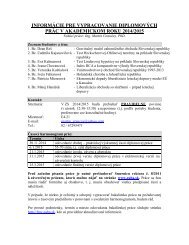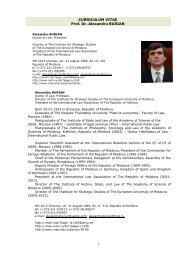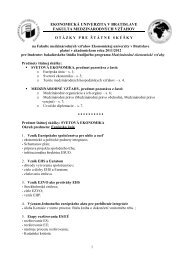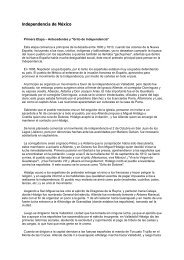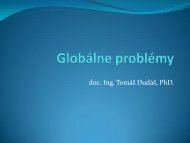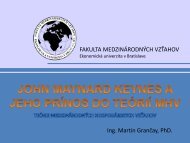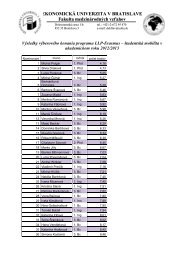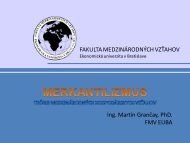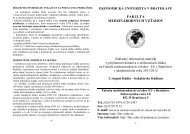rozvojová pomoc a spolupráca - Fakulta medzinárodných vzťahov
rozvojová pomoc a spolupráca - Fakulta medzinárodných vzťahov
rozvojová pomoc a spolupráca - Fakulta medzinárodných vzťahov
- No tags were found...
You also want an ePaper? Increase the reach of your titles
YUMPU automatically turns print PDFs into web optimized ePapers that Google loves.
kinds of capital is an integral aim of this process. Moreover, the whole processshould be complex in order to eliminate any of its weak points. The complexityenables also to create necessary synergies. For instance, healthy environment,decent housing, and well equipped schools generate more development as onlydecent housing and well equipped schools suited in poor environmentalconditions. These poor conditions could at the end effect cause more harmwhen compared to a balanced quantity and quality of the three. All kinds ofcapital should be therefore growing in relative and absolute terms, and besideseach individual in the society should have an equal and guaranteed access to acritical mass of each capital kind. There is also a strong correlation between anincrease of capital, e.g. incomes per capita, and its benefits for the individuals,what can be explained due to the existence of the law of diminishing returns.For instance when starting at the lower income levels, well-being, happiness,literacy, life expectancy increase more “dramatically” with an increase ofcapital available per capita 166 . The higher the capital available per capita, thelower the returns on capital are.The last aspect of the human development, that can have possibleimmense implication on future of human development and redistribution ofincomes, is a level of sustainable global income (see the previous chapter). Ifwe can not surpass this level, which is defined according to the environmentalconstraints in the form of carrying capacity 167 , then the limits to growth alsorepresent limits to human development. Capital, as a necessary precondition ofhuman development, is therefore strictly limited and can not be increased forcertain parts of population, which are supposed to undergo the process ofdevelopment.This is the last point of our discussion and we will not describe it more indetail. However, it has also not been solved among economists yet. It definitelydoes deserve higher amount of contributions from scientists and it is likely todominate the discussion in the filed of development economics for theupcoming decades.166 COMMON, M. - STAGL, S.: Ecological Economics. Cambridge University Press, 2005.167 Carrying capacity can be defined as a maximum size of population or economic activitythat can be sustained over time without undermining the ability of ecosystems to reproducethemselves and provide necessary ecosystem services (ranging from local ecosystems tobiosphere).129



